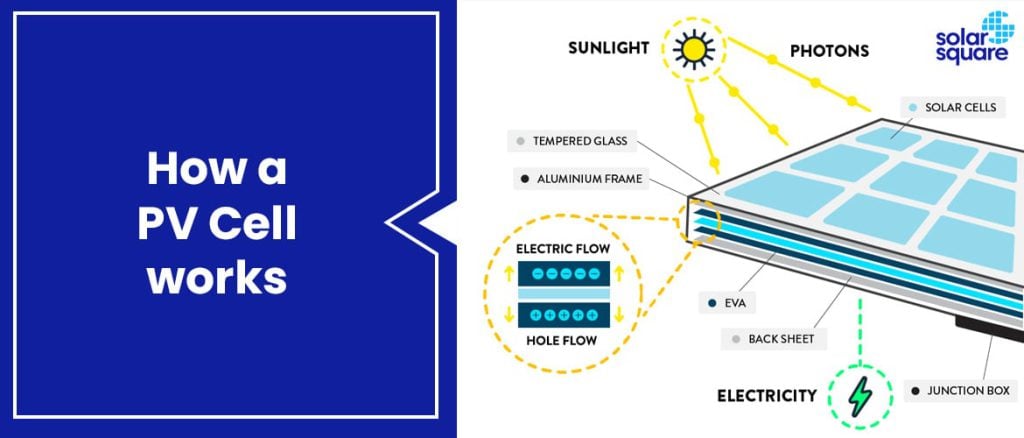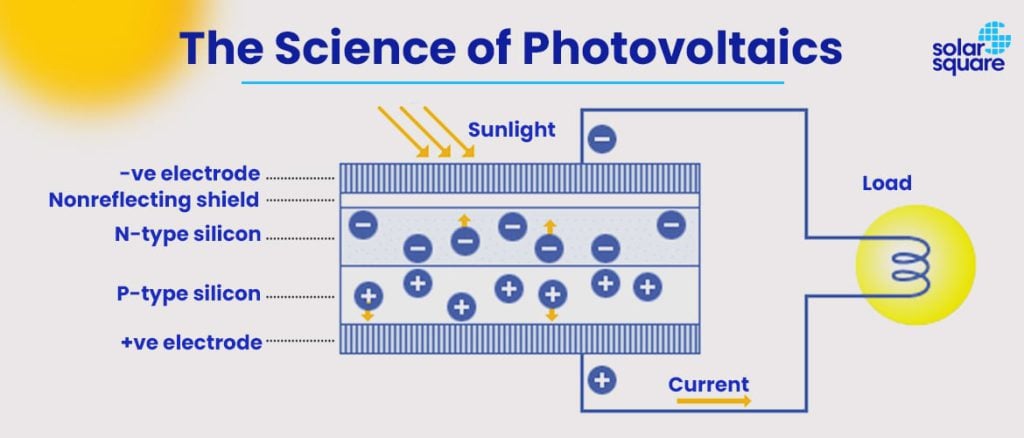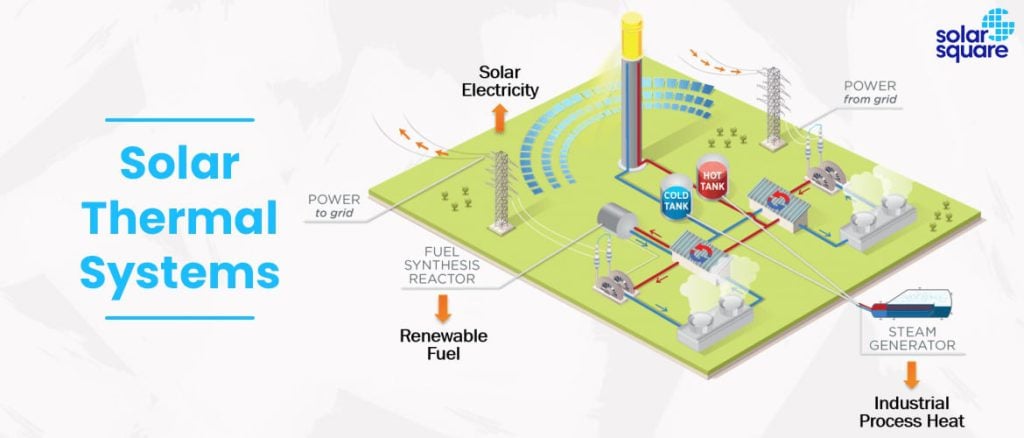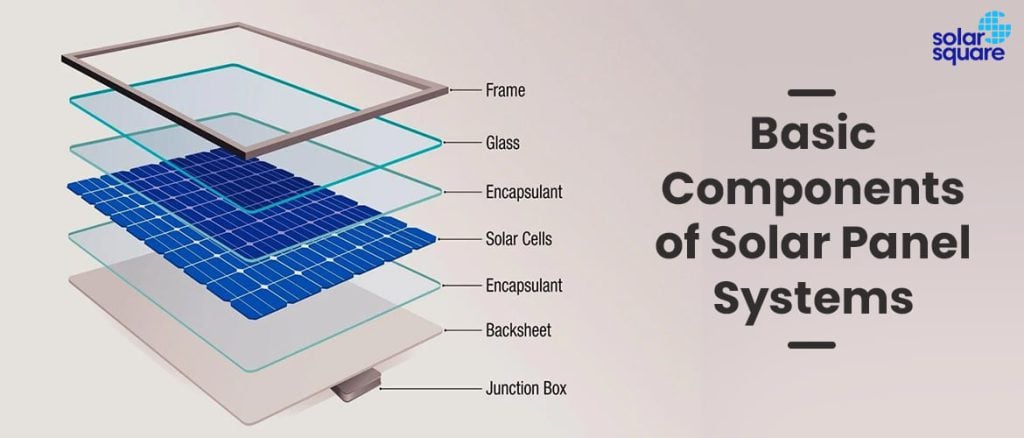
With rising electricity rates and soaring pollution levels, people have been turning towards renewable energy to save on electricity costs and protect the environment. Approximately 29 per cent of electricity currently comes from renewable sources, specifically solar.
Solar panels harness the boundless power of sunlight, transforming it into clean, free electricity.
But how do these panels work?
Solar panels are equipped with cells made from silicon. When sunlight hits these silicon cells, it excites electrons, stirring them into motion to produce an electrical current.

This guide explains how solar panels work, the components of a solar panel, and their shelf life or typical lifespan.
How Do Solar Panels Work?
India is a tropical paradise with 300-330 sunny days. The result? A whopping 5,000 kWh of sunlight every year!
When sunlight falls on the solar cells, it’s converted into electricity. Additionally, the sun’s heat can be used to generate electricity.
When the sun’s light is used to produce electricity to run appliances, the process is known as photovoltaic effect.
When the sun’s heat is used to provide direct heating or produce electricity, it’s done through thermal power systems.
Let’s walk through the basics of both.
Photovoltaics: The Science of Turning Sunlight into Electricity

Think of them as your personal energy harvesters. Each panel is filled with cells, usually made from silicon, that have one job: convert sunlight into electricity.
When the sun’s light hits these cells:
- The sunlight charges electrons, sending them on a whirlwind tour through the cell
- This movement creates an electric current
- This is direct current (DC), the first step in powering up your gadgets
But DC power cannot be used to run home appliances. DC power from solar panels can range up to 1000 volts and its let-go threshold is very high which is why a solar inverter is a vital component of a solar PV system. It receives DC power from the panels through the cables and flips it into AC power.
And this is precisely how solar panels work!
Solar Thermal Systems: When Heat Does the Heavy Lifting

Solar thermal technology is like a giant magnifying glass for the sun’s heat:
- It uses mirrors or lenses to concentrate sunlight onto a receiver, which heats a fluid
- This hot fluid is then used to produce steam
- Steam is a classic way to generate electricity or provide direct heating
Basic Components of Solar Panel Systems
A solar panel is an intricate machine made up of many components. From the solar cells to the protective glass, sturdy frame, safeguarding back sheet, and pivotal junction box, every part works harmoniously to harness the sun’s power to light up your home.

- The Solar Cells
Solar cells are the true stars of the show. They convert sunlight into electrical energy. Typically made from silicon, when sunlight hits these cells, they create an electric field that charges electrons, generating direct current (DC) electricity.
- The Glass Casing
Covering the solar cells is a tough, transparent glass layer, protecting them from rain, dust, physical damage and even excessively high temperatures, all while ensuring they get all the sunlight they need to do their job.
- The Frame
Surrounding the glass casing and the solar cells is an aluminium frame, which provides structural stability, ensuring the panel stays in place, come wind or high water.
Solar panel companies take special care to manufacture these frames as solar panels can last for 25 years (provided you invest in top brands and let professionals take care of the maintenance post-installation).
- The Back Sheet
Behind the solar cells lies the back sheet that keeps moisture and dirt out while adding an extra layer of protection. It is the unsung hero of the solar panel, working quietly in the background to ensure that everything keeps running smoothly and that the back of the solar cells is just as protected as the front.
- The Junction Box
This component serves as the bridge for the DC electricity generated by the solar cells, directing it out of the panel and towards your inverter. Without it, all the electricity generated would have nowhere to go. It acts as the bridge between the solar panel’s generation and your home’s solar power utilisation.
How to Take Care of Solar Panels?
Solar panels are the most visible parts of a solar installation, exposing them to environmental factors such as dirt and dust, bird droppings, leaves and twigs.
The PV panels need direct sunlight to work at their maximum efficiency. If you don’t clean the surface for 3-4 months, the output from solar panels can drop by 30-40%.
However, cleaning the surface of solar panels without a trained professional can be risky for the following reasons.
- Professionals use a long handle soft bristle brushes to gently clean the surface of panels without damaging it
- They use special chemicals to get rid of bird droppings
- Most importantly, they’re equipped with safety gear to prevent unwanted slips and falls
SolarSquare specialises in providing after-sales maintenance services to all its customers. Contact us for more details on how proper maintenance of solar panels post-installation ensures your initial investment in solar breaks even very soon.
Conclusion
Every solar cell basking in the sun, every light powered through the night, tells a story of transformation – one you’re a part of. Now, imagine the ripple effect of your decision to go solar. It’s not just an upgrade to your home; it’s a shining example of what can be achieved for your neighbours, friends, and city.
Want to choose solar today so there’s no sorrow tomorrow? Book a free solar consultation with SolarSquare today, and let our experts turn your rooftop into an electricity-generating machine.
Frequently Asked Questions (How Solar Panel Works)
- What are solar cells made of?
Most solar cells are made of silicon which converts sunlight into electricity. The main types of silicon used in solar cells are monocrystalline and polycrystalline.
- Monocrystalline silicon is like the gold medalist, offering high efficiency and durability
- Polycrystalline silicon is more like your reliable teammate; it is slightly less efficient but still a solid performer
- How long do solar panels last?
Solar panels are built to last, typically around 25 to 30 years. Many panels operate at reduced efficiency after their warranty period, so you can expect your solar investment to pay dividends for years or even decades.
- Are there any environmental benefits to using solar panels?
Absolutely! By choosing solar panels, you’re giving the planet a big high-five. Solar energy is clean, green, and renewable, meaning it doesn’t produce harmful greenhouse gasses or pollute our air and water. It’s like planting a whole forest in your backyard without any space because every 1 kW solar system equals plating 15 full-grown trees.
